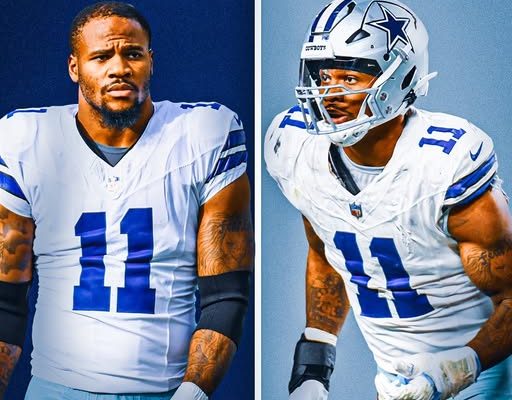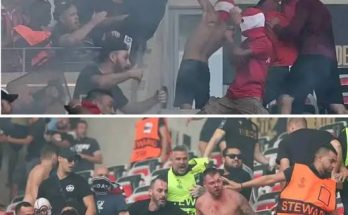When Michael Irvin speaks about the Dallas Cowboys, it’s never just casual chatter—it’s a statement, often bold, always passionate, and usually aimed at shaking the status quo. His latest proclamation may be one of the most eye-popping yet. The Cowboys legend has gone on record saying that Micah Parsons, the team’s star pass rusher and arguably the most electrifying defensive player in football, deserves a 10-year contract worth \$450 million. That’s right—\$45 million per year for a non-quarterback. It’s a figure that would reset the market in a way the NFL has rarely seen, leapfrogging even the most lucrative deals for defensive stars like T.J. Watt, who earns about \$41 million annually, and Myles Garrett, who sits at \$40 million. And Irvin isn’t backing off—he sees Parsons as not just a star, but a once-in-a-generation talent worth building the entire franchise around.
Parsons, who will turn 26 next season, has already established himself as one of the most dominant and disruptive forces in the league. Since entering the NFL, he’s been a nightmare for opposing quarterbacks, a defensive coordinator’s dream, and a cornerstone of the Cowboys’ identity. His combination of speed, power, and relentless motor is rare, even among the elite. In many ways, he’s redefined the role of a modern edge rusher, blurring the lines between linebacker and defensive end. Irvin’s proposal isn’t just about paying for past performance—it’s about projecting a decade into the future, betting that Parsons will remain the kind of game-wrecker who forces opponents to game-plan around him week after week, year after year.
But let’s pause for a moment. A decade-long contract for a defensive player? In the NFL, that’s about as rare as a solar eclipse during the Super Bowl. Teams simply don’t make those commitments outside of the quarterback position, and even then, it’s a calculated gamble. Patrick Mahomes’ 10-year, \$450 million deal with the Kansas City Chiefs is the most famous example, but Mahomes plays the most protected, most valuable position in the sport. Parsons plays on the other side of the ball, where injuries can come more suddenly and careers can take sharper turns. NFL history is littered with defensive stars who looked unstoppable for four or five years, only to see injuries, scheme changes, or simple wear and tear erode their dominance. The question is, does Parsons have the staying power to remain elite deep into his 30s?
Irvin seems to think so, and he’s framing Parsons not as just another Pro Bowler, but as the foundation for the Cowboys’ next decade. The timing of this suggestion adds intrigue, because Dallas still hasn’t extended Dak Prescott or CeeDee Lamb—two players central to the team’s current offensive success. Handing Parsons a \$450 million deal before addressing the quarterback and star receiver could create ripple effects in the locker room and the salary cap spreadsheet. Dak’s future, in particular, has been a cloud over the Cowboys’ long-term plans. If the team commits that much to Parsons, it might signal a shift in philosophy—perhaps leaning even more heavily into building around a dominant defense rather than trying to ride Dak’s arm to a championship.
From a pure football standpoint, Parsons’ impact is undeniable. His presence changes games, sometimes in ways that don’t show up in the box score. Double teams, chip blocks, and hurried throws are all part of the ripple effect he creates. In today’s NFL, where offenses are more explosive than ever, having a pass rusher who can single-handedly disrupt a game plan is arguably as important as having an elite cornerback or even a top-tier offensive tackle. Parsons is that guy. He’s the type of player who forces teams to account for him on every snap, which in turn opens opportunities for everyone else on the defense.
But the financial argument is where things get tricky. Even if we accept that Parsons is the best defensive player in football, is \$45 million a year sustainable for a team with championship aspirations? The salary cap is rising, yes, but it’s not limitless. Locking up that much money in one defensive player means making sacrifices elsewhere, and that’s before even considering that Dallas will still need to pay—or replace—Dak, CeeDee, and several key role players over the next few years. Long-term deals in the NFL are rarely as long as they look on paper; most contain escape hatches in the form of non-guaranteed years toward the back end. But even if Parsons’ hypothetical deal were structured that way, a massive signing bonus and guaranteed salary in the first several years would put real pressure on Dallas’ ability to keep the rest of the roster strong.
There’s also the matter of precedent. If Parsons gets this deal, it won’t just be about him—it will send shockwaves through the league. Other elite defenders will immediately point to his contract as the new standard, pushing their own demands upward. Teams that have been comfortable paying their best defensive players in the \$30–\$40 million range might suddenly find themselves in uncharted territory. And while every player is unique, agents are very good at using outlier contracts to drive negotiations.
Still, Irvin’s point isn’t entirely about cap math or precedent—it’s about vision. He’s imagining Parsons as the centerpiece of a team identity, a player so singularly impactful that you build the rest of the team around his abilities. It’s the same way the Rams built around Aaron Donald, or the Steelers around Troy Polamalu, or the Ravens around Ray Lewis. Those players didn’t just fill a position; they defined an era for their franchises. In Irvin’s eyes, Parsons could be that guy for Dallas—a relentless defensive terror whose presence lifts the entire organization.
Whether Jerry Jones sees it that way is another matter. Jones is no stranger to bold moves—he’s made a career out of them—but he’s also a businessman who understands that the NFL is as much about managing resources as it is about acquiring talent. The Cowboys have been here before with star players, most recently with Ezekiel Elliott, whose massive contract extension eventually became a burden on the cap as his production declined. Parsons is a different kind of player, and he’s still ascending, but that history may make Jones cautious about committing so much money for so long.
From a player’s perspective, a 10-year deal has pros and cons. On one hand, it offers incredible security—\$450 million is generational wealth, life-changing even for someone already earning millions. On the other hand, NFL players know that contracts can be restructured, renegotiated, or voided, and locking in now could mean missing out on even bigger paydays down the line if the cap continues to spike. Parsons and his camp would have to weigh the security of a long-term deal against the flexibility of shorter contracts that allow him to re-enter the market more often.
Fans, as always, are split. Some see Parsons as the kind of player you pay whatever it takes to keep, a defensive unicorn who can be the face of the franchise as the Cowboys chase their first Super Bowl in decades. Others worry that such a deal would hamstring the team’s ability to field a balanced roster, especially in a league where depth often separates contenders from pretenders. Ten years is a long time in the NFL—coaches change, schemes change, and the physical demands of the sport can change players’ careers overnight.
In the end, this debate boils down to one core question: how much is true game-changing talent worth in today’s NFL, and how far should a team go to secure it? If you believe that Parsons can maintain his dominance into his mid-30s, if you believe that he can be the defensive equivalent of a Mahomes, then maybe \$45 million a year is a bargain. But if you have any doubts—about injuries, about roster flexibility, about the inherent volatility of defensive production—then a 10-year commitment starts to feel like a dangerous gamble.
Michael Irvin clearly sees no such doubts. For him, this is about making Parsons the heartbeat of the Cowboys for the next decade, about ensuring that the team’s most dynamic talent never even comes close to wearing another uniform. Whether Jerry Jones shares that vision remains to be seen, but one thing is certain: the conversation Irvin has started won’t fade quickly. In a league where quarterback money has long been in its own stratosphere, the idea of a defender breaching that financial threshold is both revolutionary and controversial. And for a Cowboys team perpetually caught between its storied past and an elusive future, it’s exactly the kind of bold, high-stakes question that could define the next era of the franchise.
If Dallas does it, the move would send a clear message—not just to their own locker room, but to the entire NFL—that they believe in building their identity around a transcendent defensive force. If they don’t, it will be because the risks, both financial and strategic, outweigh even Parsons’ immense talent. Either way, this is a decision that will shape the Cowboys’ path for years to come, and the debate over whether to hand Micah Parsons \$450 million will remain one of the most fascinating storylines in the NFL offseason.



